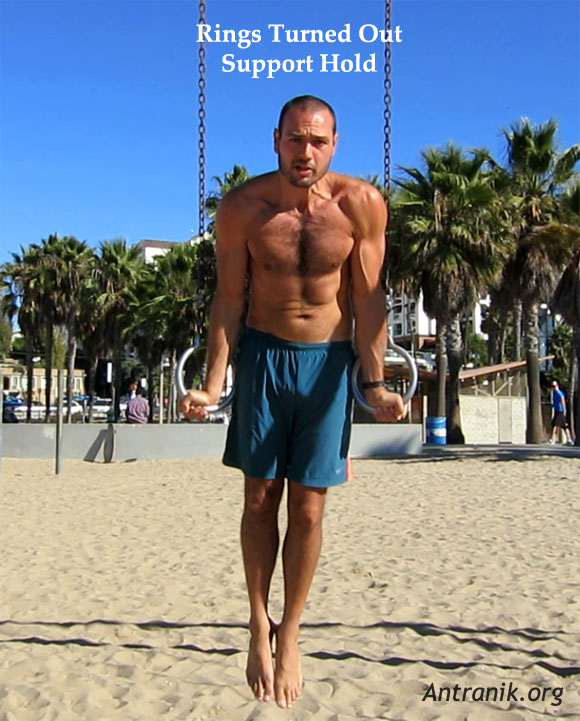Notes on Cohousing and Coliving
In pursuit of a more perfect union, let me live with my best friends.
There’s strong. There’s really strong. And then there are rings specialists.
Rings strength training constitutes the peak of bodyweight strength and conditioning. If you doubt it, watch a minute of this video and come back. Now that you’re fully convinced, I’ll lay out a training program.
The rings novice has likely never been on the rings in their life. Some standards to aim for include:
The novice will find all of these incredibly difficult at first. The support position will frustrate even accomplished weightlifters. Why are rings so difficult? It has to do with mechanical forces at work: the hand-and-arm connection between the rings and your body is not braced by a fixed object at the hands, but instead is floating on the same frictionless plane as the rings. Your arms have to not only hold your mass up but create the fixed object in space against which your arms brace your body by stabilizing the rings. The novice’s goal is to strengthen these stablizer muscles, as well other connective tissues, through repetition. You’ll find that these muscles are the main impediment to early progress, not the strength of your large muscle groups.
A word on form
It’s not sufficient to merely hang or support yourself on the rings. For essentially all elements where your mass is at or above rings-level, you should maintain a rings turned out or RTO position, to target stablizer muscle development (as well as not be deducted execution points in competition). Observe, the support position in rings with RTO:

An appropriate program would be several sets of each exercise a day with several minutes rest between sets, several times a week. After two weeks improvement, the quantity of the repetitions should increase. For instance, after the athlete warms up (which should include elbow and wrist mobility work, a program might look like:
| Exercise (3-4 sets per workout) | Weeks 1-2 | Weeks 3-4 | Weeks 5-6 |
|---|---|---|---|
| dead hang | 30 seconds | 45 seconds | 60 seconds |
| support hold | 10 seconds | 30 seconds | 45 seconds |
| dips | 10 assisted dips | one or several unassisted dips | 5 unassisted dips |
| L-seat hold | 5 seconds | 10 seconds | 15 seconds |
| rows | 10 assisted rows | one or several unassisted, inverted hanging rows | 8 unassisted, inverted hanging rows |
| pull-ups | 10 assisted pull-ups | one or several unassisted pull-ups | 8 unassisted pull-ups |
Note: for assisted movements, consider placing feet (or just one foot) on an elevated surface, placing a band through the rings and stepping on them, or having partner assist you by holding your waist.
Consider approaching the intermediate level when you are comfortable with holding a RTO (rings turned out) support position for a minute, and can do ten dips and ten pull-ups. The programming (sets and reps scheme) should conform to the approach above: several sets of a handful or more of reps, increasing volume, intensity, or upgrading the difficulty week by week. The links are to videos that demonstrate form and provide suggestions for element-specific advancement.
Here’s a bucket list (you can follow my progress). Suffice to say: progressing to this stage is legendary.
I hope that seeing what’s possible is inspiring. And I want to leave you with a thought.
High-level artistic gymnastics is generally too competitive for all but prime-age, most peak-conditioned athletes. The vast majority of professional gymnasts retire in their twenties. However there is a notable exception.
No discussion of the rings apparatus is complete without mention of Jordan Jovtchev (also transliterated Yordan Yovchev). This gymnast from Bulgaria has competed in six consecutive Olympics Games, and won the silver medal on the rings event at 31. At the European gymnastics games in 2008 he won another silver, and the bronze at the same competition in 2010, at the age of 37. He retired at 40 years old after competing in his sixth olympics.
A word on equipment
I built a nine-foot tall pull-up bar in my backyard following mainly this guide. I purchased the materials at a hardware store, and ordered these wooden rings and adjustable straps from Amazon. You can also hang your rings from a doorjamb pull-up bar indoors. It goes without saying that you should ensure your equipment is properly installed since there is a risk of falling and injury.
Links
In pursuit of a more perfect union, let me live with my best friends.
Thoughts and practical advice on a gymnast’s core compentency.
An interview with Howard Baetjer
Max Efremov’s book review of Ross Douthat’s The Decadent Society
An interview with Tyson Edwards, YouTuber and All-Around Athlete
Folks I pay attention to.
A brief survey of Richard Schwartz’s Internal Family Systems (IFS) therapy.
An interview with Alexey Guzey, researcher and writer.
Intermittent fasting for a world stuck at home.
An interview with Luke O’Geil, gymnastics coach and gymnast strength trainer.
There’s strong, there’s really strong, and then there are gymnastics rings specialists.
In extremis, rising to the occasion with a ready mind.
Why on-the-job skills aren’t the only skills to keep sharp while job searching.
A search tool centralizing information pertaining to internationally sanctioned entities.
Thoughts on the (in)feasibility of any amendment to the US Constitution.
An interview with Scott Sumner, a monetary economist.
The details of a day in the life of a Lambda School student.
Progress in gymnastics is not only within reach of most people who can walk but, with proper coaching, can be the most rewarding sport you train for.
Scathingly funny.